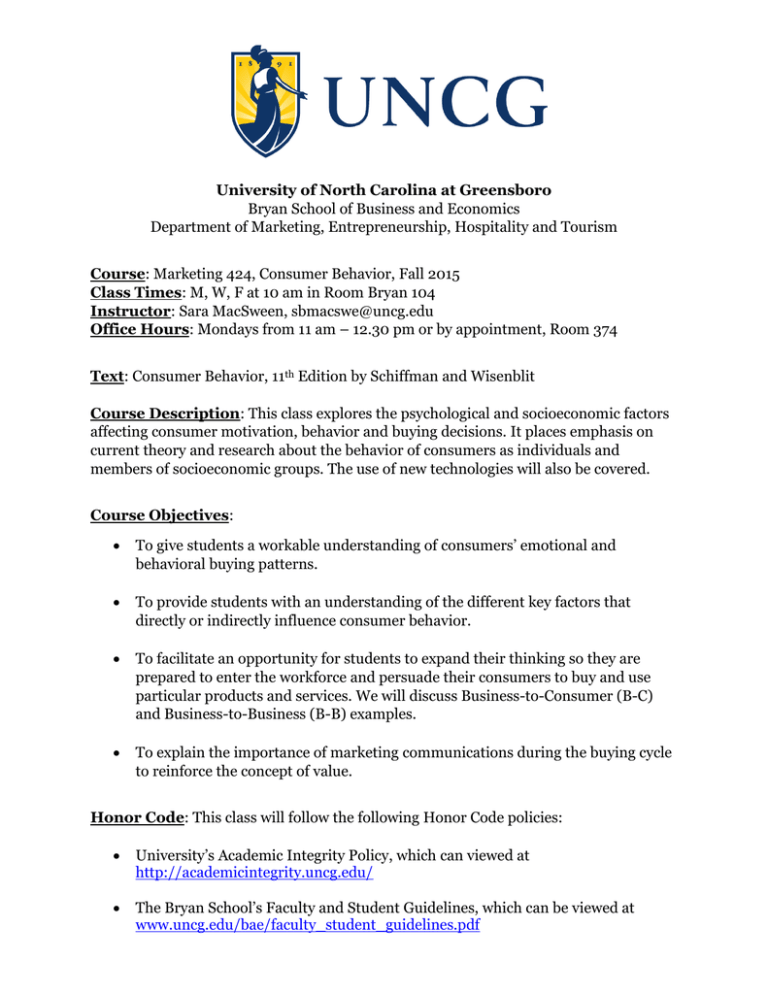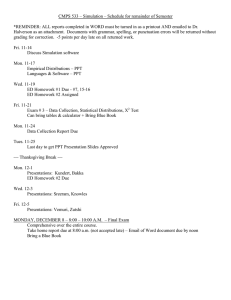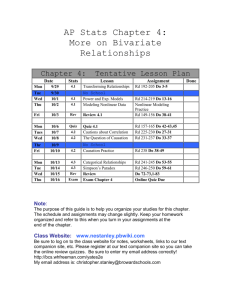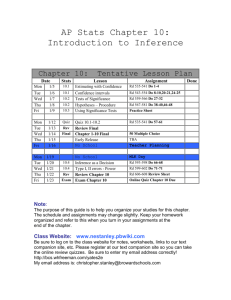University of North Carolina at Greensboro
advertisement

University of North Carolina at Greensboro Bryan School of Business and Economics Department of Marketing, Entrepreneurship, Hospitality and Tourism Course: Marketing 424, Consumer Behavior, Fall 2015 Class Times: M, W, F at 10 am in Room Bryan 104 Instructor: Sara MacSween, sbmacswe@uncg.edu Office Hours: Mondays from 11 am – 12.30 pm or by appointment, Room 374 Text: Consumer Behavior, 11th Edition by Schiffman and Wisenblit Course Description: This class explores the psychological and socioeconomic factors affecting consumer motivation, behavior and buying decisions. It places emphasis on current theory and research about the behavior of consumers as individuals and members of socioeconomic groups. The use of new technologies will also be covered. Course Objectives: To give students a workable understanding of consumers’ emotional and behavioral buying patterns. To provide students with an understanding of the different key factors that directly or indirectly influence consumer behavior. To facilitate an opportunity for students to expand their thinking so they are prepared to enter the workforce and persuade their consumers to buy and use particular products and services. We will discuss Business-to-Consumer (B-C) and Business-to-Business (B-B) examples. To explain the importance of marketing communications during the buying cycle to reinforce the concept of value. Honor Code: This class will follow the following Honor Code policies: University’s Academic Integrity Policy, which can viewed at http://academicintegrity.uncg.edu/ The Bryan School’s Faculty and Student Guidelines, which can be viewed at www.uncg.edu/bae/faculty_student_guidelines.pdf Make-up Exams: Only given if arranged prior to the exam or due to illness. If provided for an illness, students must provide a note from a physician on letterhead with a signature before a make-up exam will be given. If a student fails to appear for an exam or make-up exam, they will receive a grade of zero. Grading Midterm exam I Midterm exam II Midterm exam III Oral presentations (2 per group) Class participation 50 multiple choice questions covering chapters 1-5 50 multiple choice questions covering chapters 6-10 50 multiple choice questions covering chapters 11-16 10 minute group presentation with Q&A session, groups choose their presentation format Discussion during class and submission of in-class assignment(s) TOTAL 25% 25% 25% 20% 5% 100% Grading Scale: Final grades will be assigned as follows: 97-100 93-96 90-92 87-89 83-86 80-82 77-79 73-76 70-72 67-69 63-66 60-62 61-0 = = = = = = = = = = = = = A+ A AB+ B BC+ C CD+ D DF Oral Presentation Grading Rubric Points Item 5 points Introduce team and topic 5 points All members turn in peer evaluation forms (printed copy) 10 points Provide relevant marketing definitions and descriptions 25 points Fullness of answering the question 15 points Provide marketing insights on topic (best practice, tips, industry, etc.) 20 points Inclusion of relevant graphics and examples 10 points Presentation is 10 minutes long (points deducted if over/under time) 5 points Class interest/participation 5 points Inclusion of references Note: Up to 10 points will be deducted for individual participation based on peer evaluation forms. Class Participation Grading Rubric Points 5 points 20 points 75 points Item Upload your photo to Canvas Submission of email marketing assignment (turn in hard copy) Participation in class (earn up to 75 points) Class Expectations As instructor, I have the following responsibilities: 1. Come prepared to every class with a well thought-out class. 2. Design my class so you will understand how a marketer uses their understanding of consumer behavior to connect with consumers and prospective consumers. 3. Consider that it is not always your fault if you don’t understand the material. 4. Create a mutually respectful classroom environment. 5. Provide real working examples of how consumer behavior translates in B-C and B-B environments. As students, you have the following responsibilities: 1. Turn off your phone so you can focus on the lecture. Your smart phone is smart enough! 2. Come prepared to every class by reviewing previous notes and reading the material. It’s amazing how things make sense when you read before class! 3. Consider that it is not always the instructor’s fault when you don’t understand the material. 4. Treat others (including the instructor) with respect. 5. Ask questions when you don’t understand. Asking questions is a sign of maturity - not ignorance. Sales professionals spend a lot of time asking their customers questions. Important Notes 1. The exam consists of questions from the text (50%) and lecture (50%). If you don’t attend class, then you will miss HALF of the material on the exams. Questions also come from class presentations. Slides ARE NOT posted on Canvas. 2. Office hours are available each week for review of slides and questions. 3. Quality, not quantity, is important for class participation and oral presentations. Fall 2015 Class Schedule Date Mon, Aug 17 Wed, Aug 19 Fri, Aug 21 Mon, Aug 24 Wed, Aug 26 Fri, Aug 28 Mon, Aug 31 Wed, Sept 2 Fri, Sept 4 Mon, Sept 7 Wed, Sept 9 Fri, Sept 11 Mon, Sept 14 Wed, Sept 16 Fri, Sept 18 Mon, Sept 21 Wed, Sept 23 Fri, Sept 25 Mon, Sept 28 Wed, Sept 30 Fri, Oct 2 Mon, Oct 5 Wed, Oct 7 Fri, Oct 9 Mon, Oct 12 Wed, Oct 14 Fri, Oct 16 Mon, Oct 19 Wed, Oct 21 Fri, Oct 23 Mon, Oct 26 Wed, Oct 28 Fri, Oct 30 Mon, Nov 2 Wed, Nov 4 Fri, Nov 6 Mon, Nov 9 Wed, Nov 11 Fri, Nov 13 Mon, Nov 16 Wed, Nov 18 Fri, Nov 20 Mon, Nov 23 Wed, Nov 25 Fri, Nov 27 Mon, Nov 30 Wed, Dec 2 Activity & Team Presentations Course introduction and team assignments Chapter 1 Continuation of Chapter 1 Chapter 2 Continuation of Chapter 2 Oral Presentations - Teams 1, 2 and 3 Chapter 3 Continuation of Chapter 3 Oral Presentations – Teams 4, 5 and 6 No class – Labor Day Chapter 4 Continuation of Chapter 4 and Email marketing Chapter 5 Continuation of Chapter 5 Oral Presentations – Teams 7, 8 and 9 Midterm I Midterm I review Chapter 6 Continuation of Chapter 6 and Chapter 7 Continuation of Chapter 7 Oral presentations – Teams 10 and 11 Chapter 8 Continuation of Chapter 8 and Chapter 9 Continuation of Chapter 9 No class – Fall Break Chapter 10 Continuation of Chapter 10 Oral Presentations – Teams 1, 2 and 3 Midterm II Midterm II review Chapter 11 Continuation of Chapter 11 and Chapter 12 Continuation of Chapter 12 Chapter 13 Continuation of Chapter 13 Oral Presentations – Teams 4, 5 and 6 Chapter 14 Continuation of Chapter 14 Oral Presentations – Teams 7, 8 and 9 Chapter 15 Continuation of Chapter 15 and Chapter 16 Continuation of Chapter 16 Oral Presentations – Teams 10 and 11 No class - Thanksgiving No class - Thanksgiving Review day Midterm III from noon to 3 pm Topic for Oral Presentations 1 Team 1, Presentation 1 Team 2, Presentation 1 Team 3, Presentation 1 Team 4, Presentation 1 Team 5, Presentation 1 Team 6, Presentation 1 Team 7, Presentation 1 Team 8, Presentation 1 Team 9, Presentation 1 Team 10, Presentation 1 Team 11, Presentation 1 A company is introducing a new E-book reader. Suggest segmentation, targeting and positioning strategies for the new product. Explain which communication channels you would use. Discuss how two websites or apps you regularly visits track your behavior and enable marketers to target you effectively. Explain how companies can use this technology to enhance their marketing efforts. Discuss how different industries use this technology. Find three print advertisements directed at three different clusters, each one belonging to one of the three frameworks listed in Table 2.3: PRIZM, P$YCLE and ConneXions. Explain your choices. Discuss how clusters are used for selling product and services. Show advertisements that depict different defense mechanisms. Discuss the effectiveness of each ad and mechanism. Explain which mechanisms are suited for different industries (select five industries to discuss.) Discuss one example of a B-C and one B-B advertisement or communication that is designed to arouse consumer needs. Discuss the effectiveness of each ad. Explain how marketers should use need arousal in their marketing efforts. Find three examples of promotional methods that use ambush or experiential marketing. Discuss the effectiveness of the sensory input provided. Explain what types of products or services are best suited for different forms of ambush and experiential marketing. Select a company that produces several versions of the same product under the same name brand (not an example used in the text). Prepare a list of the benefits each item offers. Explain if you think the benefits will persuade consumers to buy each version. Discuss which promotional efforts and channels could be used to increase sales of the different versions. Find an example of two ads that target the left side of the brain and two ads that target the right side of the brain. Discuss your choices and their effectiveness. Explain how companies should use this when creating communications and promotions. Find advertisements that illustrate each of the four motivational functions of attitudes. Describe how each ad either reinforces an existing attitude or is aimed at changing an attitude. Explain how companies can effectively use these attitudes to sell products and services (provide specific examples for B-C and B-B.) Find print ads using each of the following advertising appeals: fear, sex and humor. Discuss their effectiveness and persuasive value. Explain how these appeals can also be used in B-B marketing. Should marketers use more written copy than artwork in print ads? Provide examples of two B-C and two B-B ads (total of four.) Discuss the mixture of copy vs. artwork that should be used to communicate to consumers through social media channels. Topic for Oral Presentations 2 Team 1, Presentation 2 Team 2, Presentation 2 Team 3, Presentation 2 Team 4, Presentation 2 Team 5, Presentation 2 Team 6, Presentation 2 Team 7, Presentation 2 Team 8, Presentation 2 Team 9, Presentation 2 Team 10, Presentation 2 Take pictures of three types of out-of-home media (OOHM.) Present them in class and describe their target market and effectiveness. Discuss the correlation between OOHM and the retail site. Explain which industries benefit most from OOHM. Find and present ads that encourage consumers to engage in wordof-mouth communications. Discuss the communication channels used. Explain how marketers should leverage word-of-mouth buzz to generate sales and leads. Discuss which industries are best suited. Which of the five stages of the family life cycle constitutes the most lucrative segment for each of the following products and services: (1) TV cable subscriptions, (2) Domino’s Pizza and (3) e-Readers? Explain your answers. Discuss how/when companies should target more than one life cycle with relevant examples. Find five ads promoting green products or activities. Explain whether you believe each one is effective or not. Discuss how companies should be green in their marketing efforts (B-C and B-B.) Find two good and two bad examples of advertising directed towards elderly consumers. To what degree are these ads stereotypical? Do they depict the concept of perceived age? How could these ads be improved by applying some Chapter 12’s guidelines for advertising to elderly consumer? Explain how companies should tailor communications to elderly consumers. Identify a group that can be regarded as a subculture at UNC-G. (1) Describe the norms, values and behaviors of the subculture’s members. (2) Interview five members of that subculture regarding attitudes toward the use of credit cards. (3) What are the implications of your findings for marketing credit cards to the group you selected? Explain the communications and channels needed for different subcultures. How do consumers reduce post-purchase dissonance? How can marketers provide positive reinforcement to consumers after purchase to reduce dissonance? Provide examples for B-C and B-B. Identify a product, service or style recently adopted by you/your friends. Identify the innovation and describe the diffusion process up to this point. What are characteristics of early adopters? Who didn’t adopt it? What features are likely to determine its eventual success or failure? Discuss the communications needed during the adoption process. Find and discuss ads that depict the following: exploitive targeting of children, overaggressive adverting, direct-to-consumer advertising of pharmaceuticals, cause-related marketing, societal marketing by a for-profit company and socially undesirable representation. Compile a list of consumptive behaviors that you consider unethical. For each behavior listed, explain why you view it as wrong. Also, for each behavior listed, discuss the possible reasons a person engaging in that practice may use to justify it. Discuss particular industries Team 11, Presentation 2 that are most prone to unethical marketing and more ethical ways that they can communication with consumers. Neutrogena would like to extend its facial cleanser product line. Design a qualitative and a quantitative research design. Discuss the launch campaign (communications, promotions and channels) that you would deploy for the launch based on the research.






